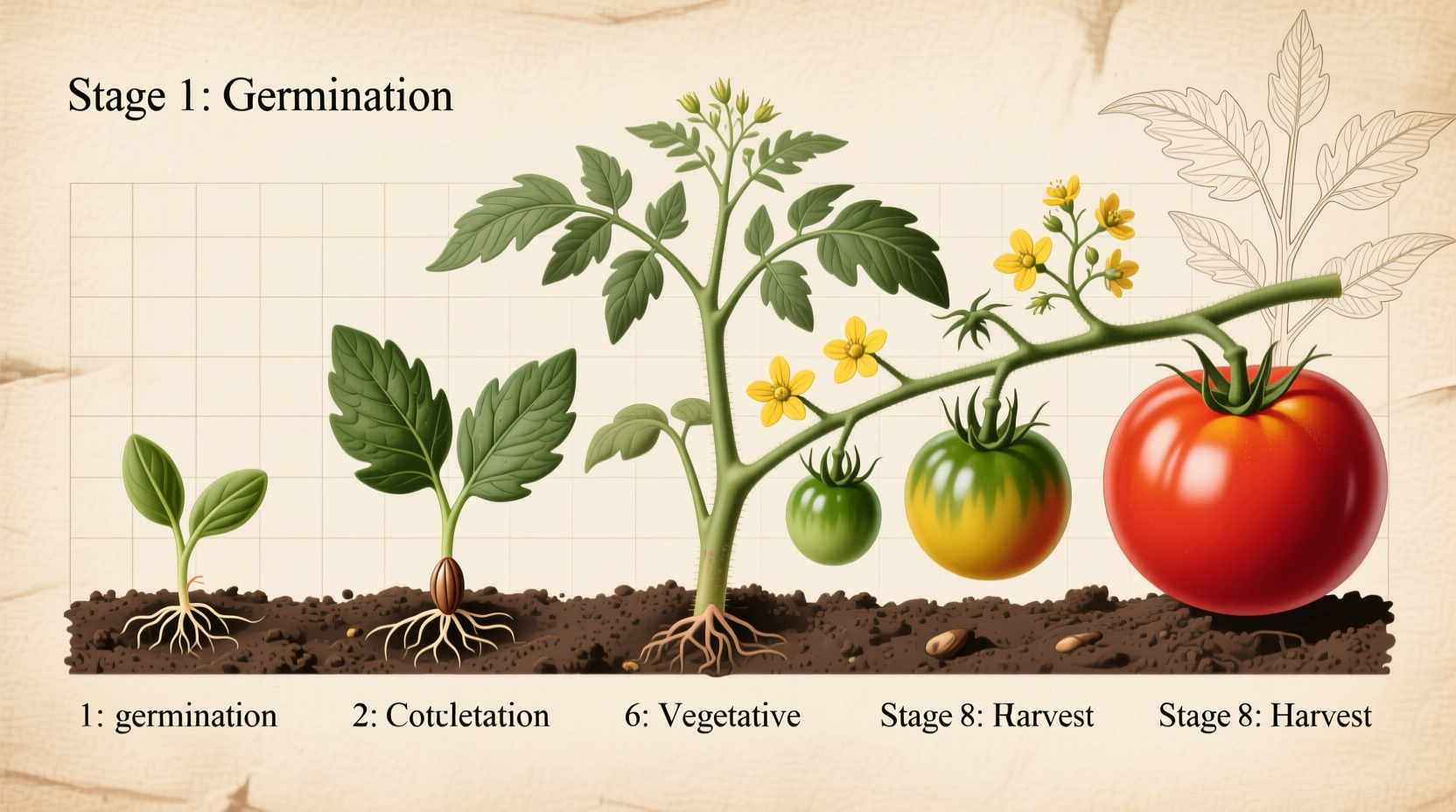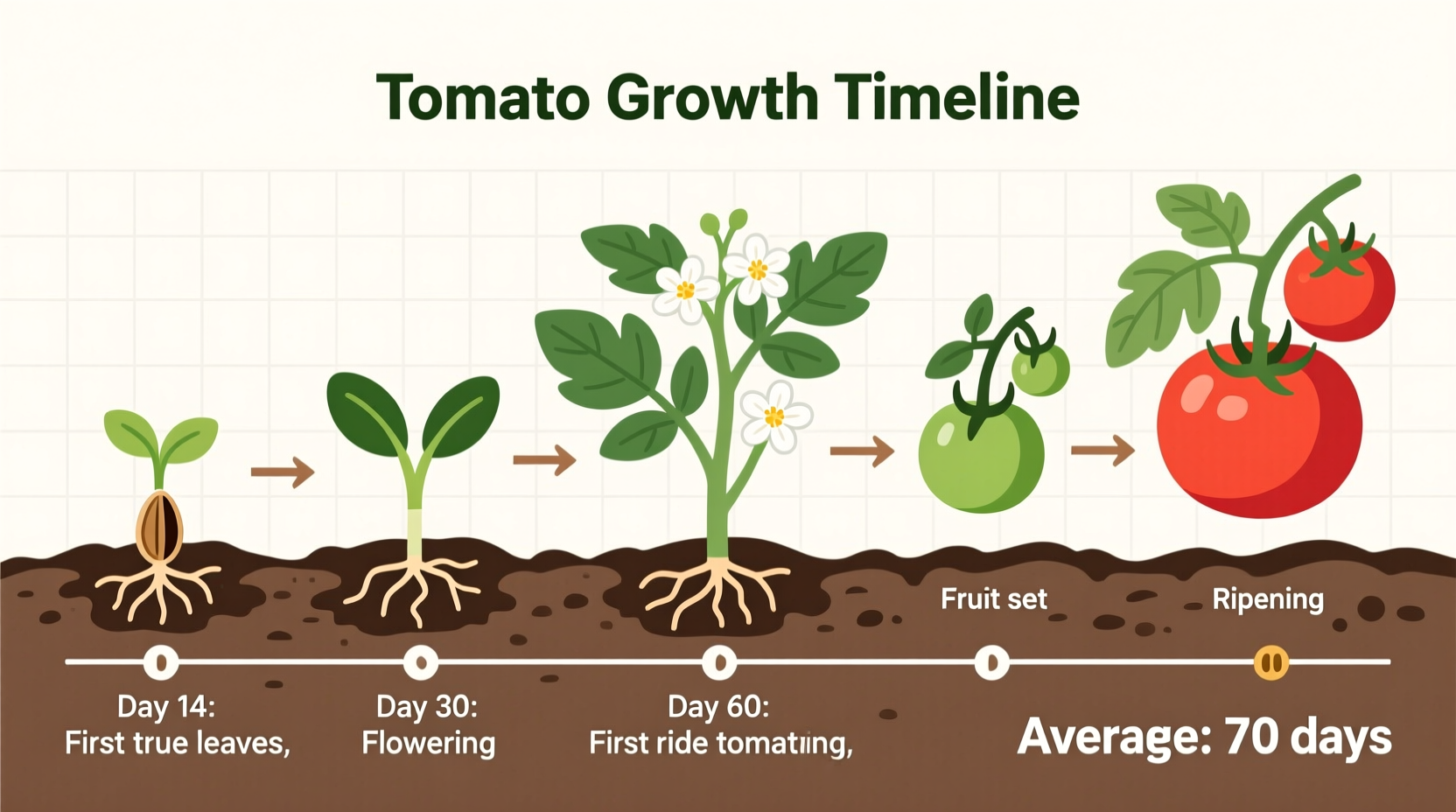Most tomato varieties take 60-100 days to grow from seed to harvest, with determinate (bush) types typically maturing in 50-80 days and indeterminate (vining) varieties requiring 65-90+ days. The actual timeframe depends on tomato variety, climate conditions, soil quality, and cultivation practices.
Understanding exactly how long tomatoes need to reach harvest helps gardeners plan their growing season effectively. Whether you're a first-time gardener planting your first container tomatoes or an experienced grower optimizing your backyard garden, knowing the precise growth timeline prevents common mistakes like harvesting too early or expecting fruit before the plant has properly developed.
Tomato Growth Stages Explained
Tomatoes progress through several distinct growth phases, each with specific time requirements and care needs. Understanding these stages helps you provide appropriate care at each critical development point.
Seed Germination (5-10 Days)
Under optimal conditions (soil temperature of 70-80°F/21-27°C), tomato seeds typically sprout within 5-10 days. Cooler temperatures significantly extend this period, while excessive heat can inhibit germination. The University of California Agriculture and Natural Resources confirms that soil temperature directly impacts germination speed, with seeds failing to sprout below 50°F (10°C).
Seedling Development (4-6 Weeks)
After germination, seedlings require 4-6 weeks of indoor growing before transplanting outdoors. During this phase, plants develop their first true leaves and establish root systems. Proper lighting (14-16 hours daily) and consistent moisture are critical for healthy development. According to Cornell University's Cooperative Extension, inadequate light during this stage causes leggy, weak plants that struggle after transplanting.

Transplanting to First Flowers (3-6 Weeks)
Following the last frost date in your region, transplanted tomatoes enter a rapid growth phase. This period, when plants establish themselves in their permanent location, typically lasts 3-6 weeks. During this time, plants develop strong root systems and produce flower clusters. The USDA notes that nighttime temperatures below 55°F (13°C) can delay flowering and fruit set.
Flowering to Harvest (45-70 Days)
Once flowers appear, tomatoes require 45-70 days to reach full harvest maturity. This critical fruit development phase varies significantly by variety. Smaller cherry tomatoes often ripen in 45-60 days after flowering, while larger beefsteak varieties may need 60-75 days. Consistent watering and proper nutrition during this stage prevent common issues like blossom end rot and cracking.
| Tomato Variety | Days to Maturity | Growth Habit | Best Climate |
|---|---|---|---|
| Early Girl | 50-62 days | Indeterminate | Cooler climates |
| Cherry Tomatoes | 55-65 days | Indeterminate | Most climates |
| Roma/Plum | 70-80 days | Determinate | Warm climates |
| Beefsteak | 75-90+ days | Indeterminate | Long growing seasons |
Key Factors That Affect Tomato Growth Time
Several environmental and cultivation factors significantly impact how long it takes for tomatoes to grow. Understanding these variables helps gardeners optimize conditions for faster, healthier production.
Climate and Temperature Conditions
Tomatoes thrive in warm conditions with daytime temperatures between 70-85°F (21-29°C). According to research from the USDA Agricultural Research Service, temperatures consistently below 55°F (13°C) or above 90°F (32°C) significantly slow growth and fruit development. In cooler climates, using black plastic mulch can increase soil temperature by 5-10°F, accelerating growth by 1-2 weeks.
Soil Quality and Preparation
Well-draining soil rich in organic matter provides the ideal foundation for tomato growth. The Cornell University Cooperative Extension recommends amending garden soil with 3-4 inches of compost before planting. Proper soil pH (6.2-6.8) ensures optimal nutrient availability, preventing deficiencies that delay growth. Container gardeners should use premium potting mixes rather than garden soil for best results.
Watering Practices
Consistent moisture is critical for steady tomato growth. Irregular watering causes stress that delays fruit development and increases problems like blossom end rot. The University of California Agriculture and Natural Resources advises providing 1-2 inches of water weekly, with increased amounts during fruiting. Morning watering reduces disease risk compared to evening irrigation.
Accelerating Your Tomato Growth Timeline
Several proven techniques can help you harvest tomatoes sooner while maintaining quality and yield.
Starting Seeds Indoors
Begin seeds 6-8 weeks before your last expected frost date. Use seed starting trays with individual cells and a quality seed starting mix. Provide strong artificial lighting (14-16 hours daily) to prevent leggy growth. Gradually acclimate seedlings to outdoor conditions through a process called hardening off before transplanting.
Proper Transplanting Techniques
Bury the stem deeper than the original soil line, removing lower leaves. This encourages additional root growth along the buried stem, creating a stronger plant that accesses more nutrients and water. Add a balanced organic fertilizer or compost at planting time to provide essential nutrients for early growth.
Strategic Fertilization
Use a balanced fertilizer (such as 5-10-10) at planting, then switch to a low-nitrogen, high-phosphorus formula when flowering begins. Excessive nitrogen promotes leafy growth at the expense of fruit production. The USDA recommends side-dressing with compost or balanced fertilizer when first fruits reach walnut size.
Pruning and Support
For indeterminate varieties, remove suckers (side shoots) to direct energy toward fruit production. Provide sturdy support with cages or trellises to keep plants off the ground. Proper air circulation reduces disease pressure that can delay growth and harvest.
Troubleshooting Common Growth Delays
Several issues can extend the time it takes for tomatoes to grow. Recognizing and addressing these problems promptly gets your plants back on track.
Slow Growth After Transplanting
If plants show little growth for 2-3 weeks after transplanting, they may be experiencing transplant shock. Ensure consistent moisture, apply a balanced liquid fertilizer, and verify that soil temperatures have stabilized above 60°F (15°C). Using row covers can provide additional warmth during cool spells.
Lack of Flowering
Excessive nitrogen, insufficient sunlight (less than 6-8 hours daily), or temperature extremes can prevent flowering. Reduce nitrogen fertilization, ensure adequate sun exposure, and be patient—most varieties begin flowering when they reach 12-18 inches in height.
Flowers but No Fruit
Poor pollination, temperature extremes, or inconsistent watering often cause blossom drop. Gently shake plants during midday to distribute pollen, maintain consistent soil moisture, and avoid fertilizing with high-nitrogen formulas during flowering.
Harvesting at Peak Ripeness
Knowing when to harvest ensures the best flavor and texture. Tomatoes continue ripening after picking, but vine-ripened fruit generally has superior taste.
Look for these signs of readiness: uniform color development (depending on variety), slight softening when gently squeezed, and easy separation from the stem with a slight twist. For the best flavor, harvest in the morning after dew has dried but before the day's heat sets in.
Understanding how long tomatoes take to grow from seed to harvest allows you to plan your gardening calendar effectively. By selecting appropriate varieties for your climate, providing optimal growing conditions, and addressing problems promptly, you can enjoy homegrown tomatoes throughout the season.











 浙公网安备
33010002000092号
浙公网安备
33010002000092号 浙B2-20120091-4
浙B2-20120091-4